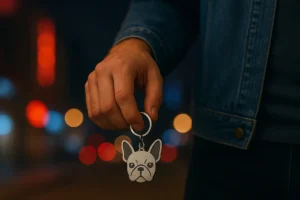Quick Answer
Adult French Bulldogs thrive on calm, consistent routines. Think short enrichment bursts, light weekly grooming, safe home habits (leashes, gates, water supervision), and paperwork readiness (ID, microchip info, clear photos). “Safe” here means everyday practical steps that keep life smooth and predictable—no medical advice, just realistic, owner-friendly habits.
TL;DR
- Daily rhythm beats marathons: several short play or training breaks work better than one long, high-intensity session.
- Light grooming cadence: weekly brushing plus regular nail, ear, and face cleaning (plain care, not treatment).
- Safety first: leash before doors open, never leave near water unattended, keep microchip details current.
- Paperwork-smart: keep registry documents handy; maintain a crisp photo set for travel profiles and lost-and-found.
- Comfortable environment: cool, well-ventilated rest areas, a predictable quiet time, and a reliable sleep spot.
How to Use This Guide
This article focuses on practical, non-medical care for adult Frenchies. It pulls tone and terminology from registries and breed-club materials, then translates that into day-to-day routines. The idea is to make life easier and safer with structure: simple grooming, home etiquette, enrichment, travel prep, and paperwork. Adjust the examples for your home (apartment vs. house, single owner vs. family).

A Day in the Life (Sample Routines)
Morning
- Calm kickoff. A short, upbeat greeting and a quick potty break set the tone.
- 10–15 minutes of enrichment. Rotate puzzles (snuffle mat, easy food puzzle) or a “sniffari” on leash around the block. The point is variety, not intensity.
- Reset. Fresh water; a few minutes of quiet on the bed or in a crate to lower the excitement curve before work or errands.
Midday Micro-breaks
- Two or three mini sessions of 5–10 minutes: hallway “with-me,” a short fetch in a soft space, or a quick hide-and-seek treat game.
- Doorway manners. Practice “wait” at an interior threshold before practicing at the front door—proof it indoors first.
- Toys on rotation. Less is more: two toys out, the rest stored. Swap daily so each item feels novel.
Evening Wind-down
- Gentle play or short training reps (sit/down/settle).
- Light grooming touchpoint (brush a few passes, quick ear/face wipe, check nails).
- Sleep setup. Guide to a quiet, well-ventilated rest area; keep bed placement consistent so nights feel predictable.
Weekends & Travel Days
- Packing checklist: ID tag checked, microchip details verified online, carrier familiarity refreshed with a treat trail in and calm exits out.
- Low-key outings: new smells, new surfaces, short visits—then home to decompress.

Home Setup & Safety
Entry/Exit Etiquette
- Leash on before the door opens. Make it automatic. A baby gate between living space and door adds a safety buffer for excited greetings or deliveries.
Secure Rest Zones
- A consistent “home base”—bed or crate—signals where settling happens. Place it away from drafts and high-traffic walkways.
Water & Supervision
- Never unattended around pools or tubs. Even confident dogs can slip. For bath days, keep mats down and towels ready, then dry thoroughly before play resumes.
ID Upkeep
- Microchip registered to your current contact info; confirm the number is correct in your account.
- ID tags updated; keep one recent photo set handy (see “Photo ID Tips”).
Grooming & Upkeep
- Weekly brush. A soft-bristle or rubber curry brush keeps the short coat tidy and removes loose hair.
- Nails, ears, and face. Regular nail care and gentle ear/face cleaning keep things neat. Keep the language basic—no treatments or diagnoses.
- Bath cadence. Use mild, low-fragrance products as needed; rinse thoroughly; towel and air-dry fully.
- Gear check. Inspect collars and harnesses for wear and re-check fit as body shape changes with age or fitness.
Enrichment & Manners (Keep It Fun)
- Brain games. Snuffle mats, rolled towels with a few hidden pieces, easy puzzle feeders.
- Polite hellos. Ask for a sit before greetings; if guests are excited, leash indoors for the first minute to prevent door dashes.
- Leash skills indoors first. Practice short “with-me” walks down a hallway, then generalize outdoors.
- Solo-time skills. Start with very short alone intervals; pair with a safe chew or a licki-mat; increase duration steadily so departures feel ordinary.
Travel & Weekender Basics (General-Info Logistics)
- Carrier acclimation. Treat trail into the carrier; door open at first; then brief closes; always end on calm exits.
- Paperwork folder. Keep registry documents, ID copies, and emergency contacts in a sleeve or digital folder.
- Car routine. Use a crash-tested harness or secured crate; plan quick water stops; park in shade where possible.
- Air travel? Pair this routine with your airline policies hub (in-cabin rules, temperature bands, station embargo notes). This article sticks to general logistics, not medical advice.
Standards Snapshot
A quick identity reference many owners like to keep with their documents.
| Registry | Accepted wording | Notes |
|---|---|---|
| AKC (U.S.) | French Bulldog | Breed page and identity basics: akc.org |
| The Kennel Club (UK) | French Bulldog | Current UK breed standard: thekennelclub.org.uk |
| FCI | Bouledogue Français / French Bulldog | Standard No. 101 (English PDF): fci.be |
(These are identity references and terminology sources, not medical resources.)
Photo ID Tips (Checklist)
- Lighting: bright, indirect daylight; avoid heavy shadows.
- Angles: front headshot, both side profiles, full-body side, and a top-down photo to show size and markings.
- Background: plain, contrasting wall or backdrop—light for dark brindle, mid-tone for cream/fawn.
- Details: close-ups of nose leather, eye rims, and any mask so pigment is visible.
- File names: use “DogName_Date_View.jpg” (e.g., “Milo_2025-09-29_ProfileRight.jpg”) so files are searchable when you need them fast.
Myths & Mislabels (Quick Busts)
- “Low maintenance means no routine.” Short coats still benefit from weekly brushing, regular nail and ear/face care, and daily check-ins.
- “Long sessions are required.” Many adult Frenchies prefer several short engagements to one long, exhausting outing.
- “A harness or collar fits forever.” Check straps regularly—fit changes with body condition and seasons.
- “Rare color equals better.” Paperwork first. Verify registry wording and skip hype; focus on temperament and a good household match.
Buying & Adoption Ethics (Paperwork First, No Hype)
- Verify identity. If registry status is claimed, ask for official certificates (AKC, The Kennel Club, or an FCI member body) and cross-check names and numbers.
- Avoid color-only decisions. Trendy labels don’t predict suitability; choose for temperament, lifestyle fit, and transparent documentation.
- Consider reputable rescues. Ask for history summaries, previous training notes, and ID records.
- Keep copies. Store digital and printed documents—handy for travel, rentals, and community registrations.
Light Care Basics
Coat & grooming: Short coat; routine brushing keeps things tidy.
Home & environment: Cool, well-ventilated rest spots and a predictable quiet time support a calm household.
On the go: Keep ID tags and microchip registration current; carry water and a simple mat for settle time.
For health concerns, consult your veterinarian.
FAQs
What does a realistic daily routine look like for an adult Frenchie?
A steady rhythm helps: a short morning enrichment session, a few five- to ten-minute play or training breaks spaced through the day, and an evening wind-down with light grooming. Consistency matters more than intensity.
How often should light grooming happen for a short coat?
A weekly brush keeps loose hair under control; pair it with quick nail checks and gentle ear/face cleaning. Think “little and often,” not marathon spa days.
What are simple ways to enrich indoor life without long walks?
Rotate puzzle feeders, snuffle mats, and brief hallway “with-me” walks. Hide a few kibble pieces in a rolled towel or under plastic cups and let your Frenchie problem-solve.
Which house rules make doorways and exits safer?
Leash on before opening an exterior door, use a baby gate as a second barrier, and practice “wait” at an interior threshold so it’s reliable when guests arrive.
How can paperwork and photos help during travel or moves?
Having registry documents, ID copies, and a neat photo set (front, profiles, body, top-down, pigment close-ups) speeds up airline, landlord, or lost-and-found processes and reduces stress when time matters.
What should owners check on harness or collar fit over time?
Look for two-finger comfort under the strap, even pressure at the chest, and no rubbing behind the elbows. Re-check seasonally and after any weight or coat changes.
Are there easy games for bad-weather days?
Yes—scatter feeding in a single room, cup games, or a two-minute training circuit (sit, down, touch, spin, settle) will burn mental energy and keep the day structured.
Disclaimer
This article provides general-information on daily routines and household organization for adult French Bulldogs. It is not medical, legal, or professional advice. Decisions about health or behavior concerns should be made with qualified professionals.
Key Takeaways
- Structure wins: short, repeatable routines keep adult Frenchies engaged without overdoing it.
- Light grooming, regularly: a weekly brush and simple upkeep go a long way for short coats.
- Safety is practical: door etiquette, water supervision, ID hygiene, and consistent rest spots.
- Paperwork-ready: maintain registry documents and a photo set for travel and emergencies.
- No hype required: focus on temperament fit and clear documentation, not buzzwords.
Sources Used (official)
- AKC — French Bulldog: https://www.akc.org/dog-breeds/french-bulldog/
- AKC — Official Breed Standard (PDF): https://images.akc.org/pdf/breeds/standards/French_Bulldog-6-18.pdf
- The Kennel Club (UK) — Breed Standard: https://www.thekennelclub.org.uk/breed-standards/utility/french-bulldog/
- FCI — French Bulldog Standard No. 101 (English PDF): https://www.fci.be/nomenclature/standards/101g09-en.pdf
- FBDCA — Breed Standard: https://frenchbulldogclub.org/breedstandard/
- FBDCA — Breed Information: https://frenchbulldogclub.org/breedinformation/
- UC Davis Veterinary Genetics Laboratory — Dog Coat Color (overview): https://vgl.ucdavis.edu/resources/dog-coat-color
Last updated: September 29, 2025



